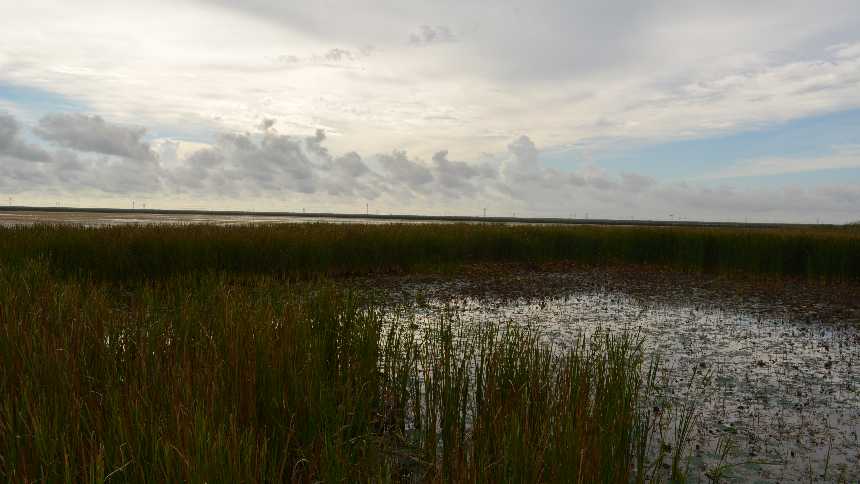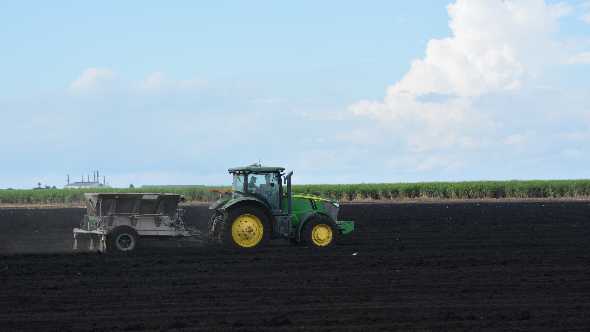South Florida Farmers Going Extra Mile For Everglades Conservation

Photo by Frank Giles
As Florida looks to 2015 and what many believe will be a momentous year for statewide water policy, it is worth studying one part of the state that already is one of the most regulated places in America and perhaps the world when it comes to water. The Everglades Agricultural Area (EAA) has a turbulent history, but also a remarkable story to tell.
In October, the Conservation Technology Information Center hosted its annual Conservation In Action Tour in the EAA. More than 150 growers, policymakers, regulators, and allied industry from across the nation attended the event. The tour crossed the EAA with numerous stops showcasing how farmers there have stepped up to the water challenge and far exceeded all expectations.
This isn’t a new issue, of course, water also set South Florida on a contentious and litigious battle royale in the late 1980s and 1990s as interests debated the fate of the Everglades and how it would be restored. While fingers pointed in different directions on who was to blame for its environmental degradation, all could agree enemy No. 1 was, and remains, phosphorous entering the delicate environment. The Everglades, by its very design, is a low-phosphorous “River of Grass” system.
Since the 1920s, efforts have been made to tame Lake Okeechobee. By and large, they were successful, though with some pretty major hiccups along the way as the system went between flood and drought cycles. The hurricanes of 1926 and 1928 reminded people of the power of the wet times. Almost 2,000 people were killed during the 1928 storm, which pushed water over the lake’s southern banks and dikes. In the 1940s, a prolonged dry period brought on muck fires that burned the high-organic soils for three years, only to be followed by the flood of 1947, which inundated South Florida from Orlando down the peninsula.
Looking for new missions after World War II, the Army Corps Of Engineers was put to work in 1948 when Congress passed the Flood Control Act, which included the Central and Southern Florida Flood Control Projects.
“They were celebrating this project,”said Tom MacVicar. The engineer, who has spent the past 20 years consulting on water challenges in South Florida, added: “It worked for the high land value on the East Coast and they used the land to build shopping malls and homes. It virtually stopped 100% of the muck fires that had plagued the Everglades for decades.”
MacVicar said these flood control projects are the reason there is an Everglades to restore and the key to making it all work is the EAA.
“Florida’s condition is generally too much water,” he said. “The farms in the EAA produce 1 million acre-feet of runoff to the Everglades per year. This is what keeps the Everglades wet and recharges it. When Lake Okeechobee goes up, the water has to go somewhere and the farms take 24% of the outflow from the lake every year, which is very important. It all works together, and the EAA is key to the economy, providing many jobs. It is a very big deal to South Florida.”
A Lot Of Lawyers Got Rich
While the EAA is a big deal to the state’s economy, it also has been a point of contention in environmental squabbles over the years. Bill Donovan, a senior engineer with the South Florida Water Management District (SFWMD), said when you put a large population next to an agricultural area and a world-renowned natural treasure, conflicts are bound to occur.
“Think of placing Yellowstone National Park right next to New York City,” he said. “It is a good comparison to South Florida and there are going to be problems.
“The phosphorus entering the system basically fertilized the whole Everglades. It was a sawgrass system, which acted as a filter to clean the water coming out of Lake Okeechobee as it flowed slowly toward the bay. So we fertilized the Everglades and it changed the plant structure and the cattails, Australian pine, and other plants started growing.”
Those environmental conflicts have carried on for years and continue today. The late ’80s and early ’90s were particularly litigious, and as one attendee of the EAA tour put it, “A lot of lawyers got rich.”
The decade-long legal battles finally culminated in the passage of the Everglades Forever Act by the state of Florida in 1994.
“It really all came together with the passage of the Act,” said Terrie Bates, who manages environmental research for the SFWMD. “This law pretty much captured every piece of what we have to solve problems. It focused on water quality and managing the water going into the Everglades and improving its hydrology.”
Huge Hurdle
The standards laid out in the Everglades Forever Act appeared insurmountable when first proposed. The Act called for water entering the national park to carry only 10 parts per billion (ppb) of phosphorous. That’s equivalent to ¼ teaspoon poured into an Olympic-sized swimming pool.

Today, growers are banding fertilizer to reduce nutrient loads and using GPS guidance for precision farming.
Photo by Frank Giles
It mandated that farmers in the EAA reduce phosphorous loads in water leaving the area by 25% of pre-BMP levels. Growers also were required to pay a $25 per-acre, per-year Everglades Privilege Tax. The tax is aimed at funding public works projects, which is the other major component of the law. Storm water treatment areas (STAs) are a big part of the plan to clean phosphorous out water as it slowly drains toward Everglades National Park.
Originally, the EAA was about 700,000 acres. Since restoration efforts began, the state has purchased about 100,000 of those acres and converted the land into environmental conservation projects.
Because of a lawsuit consent decree and the Everglades Forever Act, growers were initially held out of the loop in determining what phosphorous reduction levels would be.
Malcolm “Bubba” Wade, senior vice president of corporate strategy and business development for U.S. Sugar, said growers in the area were shocked at first by the phosphorous reduction targets.
“When this all started happening and the research on the BMPs was being developed, everyone was doing research,” he said. “We were at U.S. Sugar, UF/IFAS, and other farms were all doing research. As part of the litigation settlement back then, the SFWMD hired UF/IFAS as a consultant to develop the targets. So, the growers were limited in how closely they could work with them in coming up with the ultimate targets. “When they announced the farms should achieve a 25% reduction in phosphorous, growers almost were ready to run the UF/IFAS guys off the roof, because we had no idea if we could achieve that kind of reduction.”
But, the scientists’ predictions proved right and growers have been able pass the phosphorous-reduction target — and then some. “We have learned over the years they [UF/IFAS] knew what they were talking about,” Wade said. “The sediment controls worked, and for the past 19 years, we have averaged a 55% reduction of phosphorous in water leaving the EAA. We are very proud of this program and what we have done here. And, we are proud of the work of UF/IFAS and the BMP program that has been put in place.”
Every year, the phosphorous is measured and compared against the pre-BMP level, which was 285 metric tons coming off the EAA. This year, growers kept phosphorous down to 104 metric tons — a 63% load reduction.
Unlike other areas in the state, the EAA BMPs are mandatory and growers must test water being pumped off the farm to prove they are meeting the standard. The BMPs are built around nutrient management, sediment controls, and water management. Growers can choose from a number of practices in each area for their BMP permit. It does provide some flexibility and is not one size fits all.
In addition, growers in the area have imposed a $5 per-acre, per-year tax on themselves to fund research to further improve their productivity while protecting the local environment.
Wade told attendees growers are now banding fertilizer and soil tests are used to ensure fertilizer needs are met, but not exceeded. In addition, there’s a great deal of emphasis placed on sediment control and water management. “One of the things to keep in mind is the muck soil in the EAA is basically decayed plant matter and is high in phosphorous,” he said. “The soil is about 800,000 to 2 million ppb. Put that in comparison with 10 ppb, which is the ultimate standard going down to the Everglades.
“What did that tell us? It told us our main strategy was not just dealing with fertilizer like we read in the newspapers back in the 1990s about this fertilizer-laden water going down to the Everglades causing the cattails and all that. We found out we needed to keep these high-phosphorous muck soils out of the ditches and canals where it could ultimately end up in the water column heading to the Everglades.”
South-Bound Train
Water leaving the EAA moves into STAs where it is cleaned even more. The water comes in at about 150 ppb and the target for the STAs is to reduce phosphorous to 13 ppb.

The Everglades Agricultural Area has gotten into the rice business. It is a great cover crop and its flooded-field production helps reduce the oxidation and loss of highly organic soils.
Photo by Frank Giles
The STAs act as a huge filter to remove nutrients from water. The system relies on emergent plants like cattails, pickerel weed, and bulrush to remove the nutrients and store them in peat-like soils as they decay. Submerged plants like hydrilla, southern naiad, and chara take phosphorous directly from the water in the STAs. Algae and bacteria on or in these plants also play an important role in cleaning the water.
“Right now, we are not quite getting there with the STAs,” said Larry Gerry, STA coordinator for SFWMD. “We are getting the water down to about 20 ppb of phosphorous, which is close, but no cigar.”
To remedy this, the STAs are going to be expanded. Currently, the treatment areas cover more than 57,000 acres. The expansion will add 6,500 acres of new treatment area to the project. And, 110,000 acre-feet of additional water storage through the construction of flow equalization basins will be added. “We have spent about $1 billion on these STAs and will spend another $880 million on the expansion,” Gerry said. “That investment is to get us from the 20 ppb down to our target 13 ppb.”
Gerry emphasized that the BMPs in the EAA are a critical part of the equation, removing at least half of the nutrient load out of the water that would otherwise have come to the STAs. And, he said the STAs always are evolving and no instruction manual comes with them. “There is no other place like this in the world,” he said. “It is a giant experiment and there is ongoing science to study and improve these challenges.”
Hitting The Sweet Spot
Water flows from the STAs into several massive water conservation areas covering 865,000 acres. These areas clean the water further and are designed for water storage, flood protection, and propagating fish and wildlife.
So after billions have been spent on public works projects and growers have gone all in to help reduce nutrients, is the target of 10 ppb phosphorous being met for water that enters Everglades National Park? Yes.
“By the time the water gets down to the park, it is about 7 to 10 ppb, so we are generally in compliance,” Gerry said. “Where we struggle a little is more on the top end where the water comes out of the STAs into the conservation areas. But, that is where the expansion project will hopefully help us.”
Local Scientific Approach
During the tour, one theme was reinforced many times: That challenges are best solved at the local level with sound science to back it up. Heading into a year charged with the politics of water, this approach should be remembered and repeated.
As grower Paul Orsenigo puts it: “EAA growers are very proud of the positive results we have achieved here over the past 25 years, especially considering all the unknowns in the early days and relative lack of research on the subject at the time.
“By proactively cooperating with local agencies and making huge investments in technology, science-based research, and on-farm BMPs, EAA growers have shown their commitment to the Everglades and the South Florida environment.”

Photo by Frank Giles
Barn Owl Boxes
One stop during the Conservation In Action Tour ventured away from water to feature the barn owl boxes that are an important pest control tool in the area. The tall poles with wooden boxes on top checker the landscape in the EAA.
The boxes make a perfect home for barn owls, which have a voracious appetite for the rodents that do damage to the crops grown in the area. The conservation program provides the owls a home, and they return the favor by keeping rodent populations in check.
Local students help build the boxes and learn about conservation in the EAA in the process.










